Dimitrios Kanoulas
The Starlink Robot: A Platform and Dataset for Mobile Satellite Communication
Jun 24, 2025Abstract:The integration of satellite communication into mobile devices represents a paradigm shift in connectivity, yet the performance characteristics under motion and environmental occlusion remain poorly understood. We present the Starlink Robot, the first mobile robotic platform equipped with Starlink satellite internet, comprehensive sensor suite including upward-facing camera, LiDAR, and IMU, designed to systematically study satellite communication performance during movement. Our multi-modal dataset captures synchronized communication metrics, motion dynamics, sky visibility, and 3D environmental context across diverse scenarios including steady-state motion, variable speeds, and different occlusion conditions. This platform and dataset enable researchers to develop motion-aware communication protocols, predict connectivity disruptions, and optimize satellite communication for emerging mobile applications from smartphones to autonomous vehicles. The project is available at https://github.com/StarlinkRobot.
Follow Everything: A Leader-Following and Obstacle Avoidance Framework with Goal-Aware Adaptation
May 01, 2025



Abstract:Robust and flexible leader-following is a critical capability for robots to integrate into human society. While existing methods struggle to generalize to leaders of arbitrary form and often fail when the leader temporarily leaves the robot's field of view, this work introduces a unified framework addressing both challenges. First, traditional detection models are replaced with a segmentation model, allowing the leader to be anything. To enhance recognition robustness, a distance frame buffer is implemented that stores leader embeddings at multiple distances, accounting for the unique characteristics of leader-following tasks. Second, a goal-aware adaptation mechanism is designed to govern robot planning states based on the leader's visibility and motion, complemented by a graph-based planner that generates candidate trajectories for each state, ensuring efficient following with obstacle avoidance. Simulations and real-world experiments with a legged robot follower and various leaders (human, ground robot, UAV, legged robot, stop sign) in both indoor and outdoor environments show competitive improvements in follow success rate, reduced visual loss duration, lower collision rate, and decreased leader-follower distance.
Immersive Teleoperation Framework for Locomanipulation Tasks
Apr 21, 2025Abstract:Recent advancements in robotic loco-manipulation have leveraged Virtual Reality (VR) to enhance the precision and immersiveness of teleoperation systems, significantly outperforming traditional methods reliant on 2D camera feeds and joystick controls. Despite these advancements, challenges remain, particularly concerning user experience across different setups. This paper introduces a novel VR-based teleoperation framework designed for a robotic manipulator integrated onto a mobile platform. Central to our approach is the application of Gaussian splatting, a technique that abstracts the manipulable scene into a VR environment, thereby enabling more intuitive and immersive interactions. Users can navigate and manipulate within the virtual scene as if interacting with a real robot, enhancing both the engagement and efficacy of teleoperation tasks. An extensive user study validates our approach, demonstrating significant usability and efficiency improvements. Two-thirds (66%) of participants completed tasks faster, achieving an average time reduction of 43%. Additionally, 93% preferred the Gaussian Splat interface overall, with unanimous (100%) recommendations for future use, highlighting improvements in precision, responsiveness, and situational awareness. Finally, we demonstrate the effectiveness of our framework through real-world experiments in two distinct application scenarios, showcasing the practical capabilities and versatility of the Splat-based VR interface.
Unreal Robotics Lab: A High-Fidelity Robotics Simulator with Advanced Physics and Rendering
Apr 19, 2025Abstract:High-fidelity simulation is essential for robotics research, enabling safe and efficient testing of perception, control, and navigation algorithms. However, achieving both photorealistic rendering and accurate physics modeling remains a challenge. This paper presents a novel simulation framework--the Unreal Robotics Lab (URL) that integrates the Unreal Engine's advanced rendering capabilities with MuJoCo's high-precision physics simulation. Our approach enables realistic robotic perception while maintaining accurate physical interactions, facilitating benchmarking and dataset generation for vision-based robotics applications. The system supports complex environmental effects, such as smoke, fire, and water dynamics, which are critical for evaluating robotic performance under adverse conditions. We benchmark visual navigation and SLAM methods within our framework, demonstrating its utility for testing real-world robustness in controlled yet diverse scenarios. By bridging the gap between physics accuracy and photorealistic rendering, our framework provides a powerful tool for advancing robotics research and sim-to-real transfer.
Underwater Robotic Simulators Review for Autonomous System Development
Apr 08, 2025Abstract:The increasing complexity of underwater robotic systems has led to a surge in simulation platforms designed to support perception, planning, and control tasks in marine environments. However, selecting the most appropriate underwater robotic simulator (URS) remains a challenge due to wide variations in fidelity, extensibility, and task suitability. This paper presents a comprehensive review and comparative analysis of five state-of-the-art, ROS-compatible, open-source URSs: Stonefish, DAVE, HoloOcean, MARUS, and UNav-Sim. Each simulator is evaluated across multiple criteria including sensor fidelity, environmental realism, sim-to-real capabilities, and research impact. We evaluate them across architectural design, sensor and physics modeling, task capabilities, and research impact. Additionally, we discuss ongoing challenges in sim-to-real transfer and highlight the need for standardization and benchmarking in the field. Our findings aim to guide practitioners in selecting effective simulation environments and inform future development of more robust and transferable URSs.
Exploring Adversarial Obstacle Attacks in Search-based Path Planning for Autonomous Mobile Robots
Apr 08, 2025



Abstract:Path planning algorithms, such as the search-based A*, are a critical component of autonomous mobile robotics, enabling robots to navigate from a starting point to a destination efficiently and safely. We investigated the resilience of the A* algorithm in the face of potential adversarial interventions known as obstacle attacks. The adversary's goal is to delay the robot's timely arrival at its destination by introducing obstacles along its original path. We developed malicious software to execute the attacks and conducted experiments to assess their impact, both in simulation using TurtleBot in Gazebo and in real-world deployment with the Unitree Go1 robot. In simulation, the attacks resulted in an average delay of 36\%, with the most significant delays occurring in scenarios where the robot was forced to take substantially longer alternative paths. In real-world experiments, the delays were even more pronounced, with all attacks successfully rerouting the robot and causing measurable disruptions. These results highlight that the algorithm's robustness is not solely an attribute of its design but is significantly influenced by the operational environment. For example, in constrained environments like tunnels, the delays were maximized due to the limited availability of alternative routes.
Discovery of skill switching criteria for learning agile quadruped locomotion
Feb 10, 2025Abstract:This paper develops a hierarchical learning and optimization framework that can learn and achieve well-coordinated multi-skill locomotion. The learned multi-skill policy can switch between skills automatically and naturally in tracking arbitrarily positioned goals and recover from failures promptly. The proposed framework is composed of a deep reinforcement learning process and an optimization process. First, the contact pattern is incorporated into the reward terms for learning different types of gaits as separate policies without the need for any other references. Then, a higher level policy is learned to generate weights for individual policies to compose multi-skill locomotion in a goal-tracking task setting. Skills are automatically and naturally switched according to the distance to the goal. The proper distances for skill switching are incorporated in reward calculation for learning the high level policy and updated by an outer optimization loop as learning progresses. We first demonstrated successful multi-skill locomotion in comprehensive tasks on a simulated Unitree A1 quadruped robot. We also deployed the learned policy in the real world showcasing trotting, bounding, galloping, and their natural transitions as the goal position changes. Moreover, the learned policy can react to unexpected failures at any time, perform prompt recovery, and resume locomotion successfully. Compared to discrete switch between single skills which failed to transition to galloping in the real world, our proposed approach achieves all the learned agile skills, with smoother and more continuous skill transitions.
Watch Your STEPP: Semantic Traversability Estimation using Pose Projected Features
Jan 29, 2025Abstract:Understanding the traversability of terrain is essential for autonomous robot navigation, particularly in unstructured environments such as natural landscapes. Although traditional methods, such as occupancy mapping, provide a basic framework, they often fail to account for the complex mobility capabilities of some platforms such as legged robots. In this work, we propose a method for estimating terrain traversability by learning from demonstrations of human walking. Our approach leverages dense, pixel-wise feature embeddings generated using the DINOv2 vision Transformer model, which are processed through an encoder-decoder MLP architecture to analyze terrain segments. The averaged feature vectors, extracted from the masked regions of interest, are used to train the model in a reconstruction-based framework. By minimizing reconstruction loss, the network distinguishes between familiar terrain with a low reconstruction error and unfamiliar or hazardous terrain with a higher reconstruction error. This approach facilitates the detection of anomalies, allowing a legged robot to navigate more effectively through challenging terrain. We run real-world experiments on the ANYmal legged robot both indoor and outdoor to prove our proposed method. The code is open-source, while video demonstrations can be found on our website: https://rpl-cs-ucl.github.io/STEPP
Real-Time Metric-Semantic Mapping for Autonomous Navigation in Outdoor Environments
Nov 30, 2024


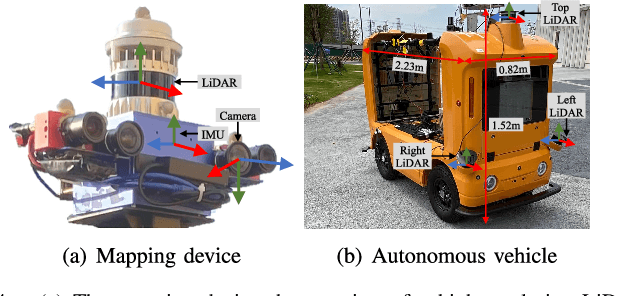
Abstract:The creation of a metric-semantic map, which encodes human-prior knowledge, represents a high-level abstraction of environments. However, constructing such a map poses challenges related to the fusion of multi-modal sensor data, the attainment of real-time mapping performance, and the preservation of structural and semantic information consistency. In this paper, we introduce an online metric-semantic mapping system that utilizes LiDAR-Visual-Inertial sensing to generate a global metric-semantic mesh map of large-scale outdoor environments. Leveraging GPU acceleration, our mapping process achieves exceptional speed, with frame processing taking less than 7ms, regardless of scenario scale. Furthermore, we seamlessly integrate the resultant map into a real-world navigation system, enabling metric-semantic-based terrain assessment and autonomous point-to-point navigation within a campus environment. Through extensive experiments conducted on both publicly available and self-collected datasets comprising 24 sequences, we demonstrate the effectiveness of our mapping and navigation methodologies. Code has been publicly released: https://github.com/gogojjh/cobra
SDS -- See it, Do it, Sorted: Quadruped Skill Synthesis from Single Video Demonstration
Oct 15, 2024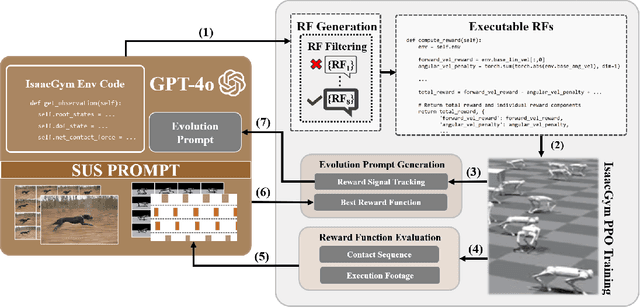
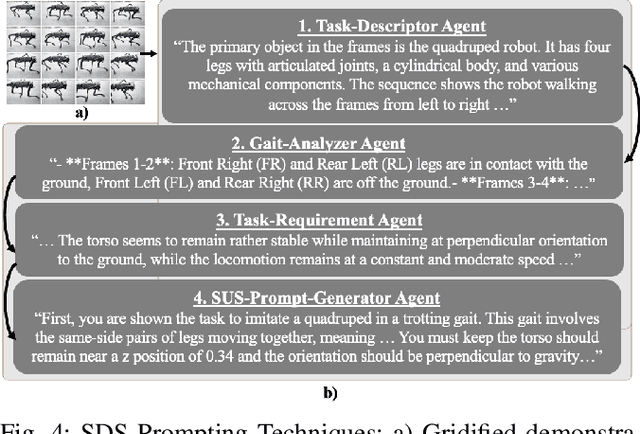
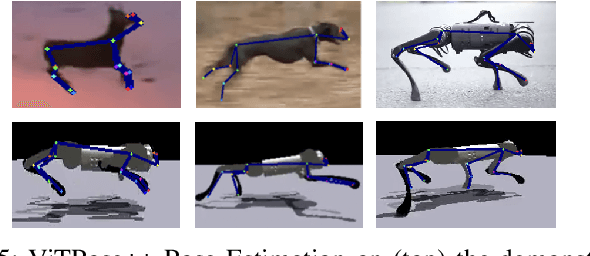
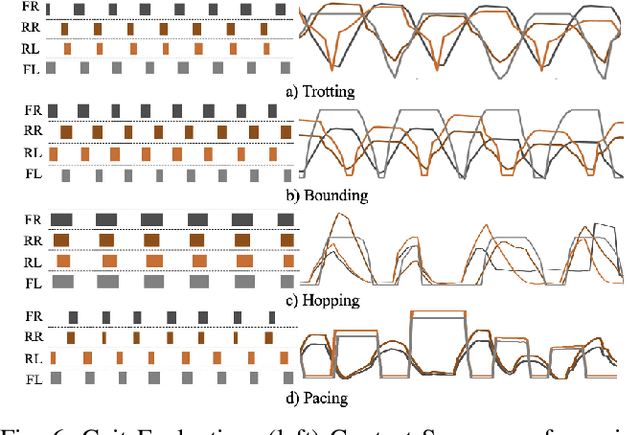
Abstract:In this paper, we present SDS (``See it. Do it. Sorted.''), a novel pipeline for intuitive quadrupedal skill learning from a single demonstration video. Leveraging the Visual capabilities of GPT-4o, SDS processes input videos through our novel chain-of-thought promoting technique (SUS) and generates executable reward functions (RFs) that drive the imitation of locomotion skills, through learning a Proximal Policy Optimization (PPO)-based Reinforcement Learning (RL) policy, using environment information from the NVIDIA IsaacGym simulator. SDS autonomously evaluates the RFs by monitoring the individual reward components and supplying training footage and fitness metrics back into GPT-4o, which is then prompted to evolve the RFs to achieve higher task fitness at each iteration. We validate our method on the Unitree Go1 robot, demonstrating its ability to execute variable skills such as trotting, bounding, pacing and hopping, achieving high imitation fidelity and locomotion stability. SDS shows improvements over SOTA methods in task adaptability, reduced dependence on domain-specific knowledge, and bypassing the need for labor-intensive reward engineering and large-scale training datasets. Additional information and the open-sourced code can be found in: https://rpl-cs-ucl.github.io/SDSweb
 Add to Chrome
Add to Chrome Add to Firefox
Add to Firefox Add to Edge
Add to Edge